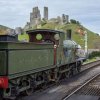Chris and Derek were indeed on the 1:32 stand at the G1MRA AGM, though I didn't catch Chris on camera.
Never mind, here's John Green with Derek:

From the left, there's my A4-sized display of refining a modestly-priced commercial insulated wheel from G1MRA Standard to Dead Scale using hand tools in a simple woodworking lathe. On the left is a four-jaw chuck accessory for centring up a complete wheelset accurately, and on the right is a conical mandrel that holds an individual wheel square and true regardless of exact hole bore. In the middle are sample wheels, Before and after.
Next, Dave Bowden's Siphon C in progress, with the Tenmille etches he's adapted.
Thanks to his advice, I'm almost there with details for the 1:32 Siphon Gs I collected from Ken West at the show. (Damn! I forgot to get wheelsets!)
Then John with his locomotives, and a heavy pile of etches for collaborators to collect - so at least some of you were there on the day ;-)
Swivelling view:

Next is Derek, with his wonderful Warship and, behind it, a posse of 3D-Printed railwaymen. While they appear to be in the union (
No
Use
Rushing ) it's the embarrassment of being stared at that's keeping them immobile inside their IKEA rotating display case.
The Slaters Ricketts wagon is awesomely finished, to the point where I bet it would be hard to identify its size from a good photo. As a London-based wagon, it's ideal for my Widened Lines fleet, so no wonder Derek keeps it locked-up!
(Not knocking rail unions: I was a Shop Steward myself.)
Then Chris's prototype Adams T3, and some very fine lattice signals.
And finally, Dave makes a point:

Beyond him and John, you can just see Alan Bullock on the Gauge One 3D Circle stand.
(We gave them a ride on 'our' tables because, while Making is scale-neutral, it's even more important to Finescalers than it is to others.)
While the show wasn't overcrowded, it was buzzing with excitement, especially a couple of dozen men and women in their teens and twenties re-enacting scenes from Thomas & Friends using some of the original TV props.
OK it was 10mm, and their target audience was on Twitter. But they took huge care over loose-laying their ballast with a correct shoulder, and getting their scenes Just Right - viz embryo Finescalers. Besides, when was the last time you saw this many folk with no white hairs at a G1-only event? ;-)

Thanks to Dave, John, Chris, Derek, and all who stopped by to chat.
David 1/2d
 but your excellent threads are great way to learn how things can be done - thank you!
but your excellent threads are great way to learn how things can be done - thank you! 









 . Fabulous work. I am always in awe of such fine work as this.
. Fabulous work. I am always in awe of such fine work as this.



 Either way, it must have been fun for the fireman dragging the coal forward when moving.
Either way, it must have been fun for the fireman dragging the coal forward when moving.























